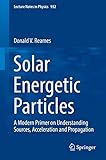Solar Energetic Particles [electronic resource] : A Modern Primer on Understanding Sources, Acceleration and Propagation / by Donald V. Reames.
Material type: TextSeries: Lecture Notes in Physics ; 932Publisher: Cham : Springer International Publishing : Imprint: Springer, 2017Edition: 1st ed. 2017Description: XVI, 127 p. 79 illus., 61 illus. in color. online resourceContent type: text Media type: computer Carrier type: online resourceISBN: 9783319508719Subject(s): Space sciences | Plasma (Ionized gases) | Geophysics | Observations, Astronomical | Astronomy—Observations | Space Sciences (including Extraterrestrial Physics, Space Exploration and Astronautics) | Plasma Physics | Geophysics/Geodesy | Astronomy, Observations and TechniquesAdditional physical formats: Printed edition:: No title; Printed edition:: No titleDDC classification: 520 | 500.5 LOC classification: QB495-500.269Online resources: Click here to access online
TextSeries: Lecture Notes in Physics ; 932Publisher: Cham : Springer International Publishing : Imprint: Springer, 2017Edition: 1st ed. 2017Description: XVI, 127 p. 79 illus., 61 illus. in color. online resourceContent type: text Media type: computer Carrier type: online resourceISBN: 9783319508719Subject(s): Space sciences | Plasma (Ionized gases) | Geophysics | Observations, Astronomical | Astronomy—Observations | Space Sciences (including Extraterrestrial Physics, Space Exploration and Astronautics) | Plasma Physics | Geophysics/Geodesy | Astronomy, Observations and TechniquesAdditional physical formats: Printed edition:: No title; Printed edition:: No titleDDC classification: 520 | 500.5 LOC classification: QB495-500.269Online resources: Click here to access online  E-BOOKS
E-BOOKS
| Current library | Home library | Call number | Materials specified | URL | Status | Date due | Barcode |
|---|---|---|---|---|---|---|---|
| IMSc Library | IMSc Library | Link to resource | Available | EBK15677 |
Introduction -- History -- Distinguishing Two Sources -- Impulsive SEP events -- Gradual SEP Events -- High Energies and Radiation Effects -- Measurements of SEPs -- Summary and Conclusions.
This concise primer introduces the non-specialist reader to the physics of solar energetic particles (SEP) and systematically reviews the evidence for the two main mechanisms which lead to the so-called impulsive and gradual SEP events. More specifically, the timing of the onsets, the longitude distributions, the high-energy spectral shapes, the correlations with other solar phenomena (e.g. coronal mass ejections), as well as the all-important elemental and isotopic abundances of SEPs are investigated. Impulsive SEP events are related to magnetic reconnection in solar flares and jets. The concept of shock acceleration by scattering on self-amplified Alfvén waves is introduced, as is the evidence of reacceleration of impulsive-SEP material in the seed population accessed by the shocks in gradual events. The text then develops processes of transport of ions out to an observer. Finally, a new technique to determine the source plasma temperature in both impulsive and gradual events is demonstrated. Last but not least the role of SEP events as a radiation hazard in space is mentioned and a short discussion of the nature of the main particle telescope designs that have contributed to most of the SEP measurements is given.


There are no comments on this title.